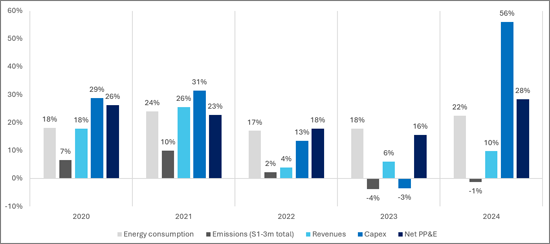
AI 혁명이 현실로 다가오고 있으며, 2025년에는 그 기세가 주류 시장으로까지 확산되고 있습니다. 하지만 그 엔진은 그 어느 때보다 엄청난 전력으로 움직이고 있습니다. 이 보고서는 웹스케일 및 AI 컴퓨팅 산업의 에너지 사용 현황을 종합적으로 분석하고, 이러한 변화의 중심에 있는 주요 사업자를 평가합니다. 본 보고서는 기존 통신사업자의 에너지 지속가능성 분석을 확장하고, 2025년 6월까지 시장 데이터를 포괄하는 독자적인 웹스케일 재무 추적 조사를 활용하고 있습니다.

웹스케일 부문은 대규모(하이퍼스케일) 데이터센터와 해저 케이블 네트워크를 소유하고 운영하는 인터넷, 소프트웨어 및 서비스 기업으로 구성됩니다. MTN 컨설팅이 2017년 분석을 시작한 초기에 이들 기업이 하이퍼스케일 데이터센터를 구축하는 주요 목적은 방대한 고객 기반 지원(예: Tencent의 WeChat), 클라우드 서비스 제공(예: Amazon AWS), 내부 업무 및 연구 개발의 운영의 세 가지였습니다. 그러나 지난 3년 동안 이들 기업은 AI 학습 및 추론에 특화된 더 크고 정교한 데이터센터를 구축하기 시작했습니다.
본 보고서에서는 세계 주요 웹스케일 기업 20개사를 대상으로 재무지표(수익, 설비투자, 순PP&E), 에너지 관련 지표(총에너지&전력소비량, 재생에너지 비율, 온실가스 배출량)를 분석하여 제시합니다. 데이터 기간은 2019-2024년이며, 에너지 사용 및 지속가능성 추세를 파악할 수 있는 파생 지표를 사용하여 분석합니다.
조사 대상은 감사받은 재무제표와 투명한 비즈니스 모델을 가진 상장기업으로 한정하고 있습니다. AI 투자 붐으로 GPU 렌탈 네오 클라우드 제공업체, 저비용 전력을 노리는 기업 등 수많은 신생 사업자들이 등장했지만, 사업모델이 확립되지 않은 기업이 많아 장기적인 생존 가능성은 미지수입니다. 일부 중요한 비상장 기업(예: Elon Musk의 xAI 등)도 조사 대상에서 제외했습니다.
본 보고서가 전 세계 모든 데이터센터를 포괄하는 것은 아니지만, 조사 대상에 포함된 상장 웹스케일 기업들은 전 세계 하이퍼스케일 용량의 대부분을 차지하고 있기 때문에 시장 전망를 좌우하는 주요 기업이라고 할 수 있습니다. 중요한 민간 사업자와 통신사 중립적 사업자가 코로케이션 서비스를 제공하고 있으며, 많은 소규모 시설이 특정 정부 기관과 기업의 요구를 충족시키고 있지만, 본 조사에서는 시장을 지배하는 주요 리더 기업에 초점을 맞췄습니다.
데이터는 이 산업이 급속한 변화의 한가운데에 있다는 것을 보여줍니다. 2024년에만 웹스케일 산업은 190.8TWh의 에너지를 소비할 것으로 예상되며, 이는 전년 대비 22% 증가한 수치입니다. 2019년 이후 에너지 사용량은 CAGR 19.9%의 속도로 성장하고 있으며, 이는 업계 전반의 일반적인 예측을 크게 상회하는 수치입니다. 이러한 성장은 AI 붐과 깊은 관련이 있습니다.
데이터는 AI에 대한 투자가 웹 스케일러의 에너지 집약도를 크게 증가시키고 있음을 명확하게 보여줍니다. 2019년에는 업계 전체가 매출 100만 달러당 51.7MWh를 소비했지만, 2024년 말에는 100만 달러당 71.5MWh로 증가할 것으로 예측됩니다. 2024년에는 에너지 집약도 상승이 가속화되어 에너지 소비 증가 속도가 수익의 두 배를 넘어섰습니다. 소비되는 에너지의 85-90%는 데이터센터에서 발생하며, 그 비율은 더욱 증가하고 있습니다. 특히 메타의 경우 총 에너지 소비의 97% 이상이 데이터센터에 집중되어 있습니다.
이러한 강력한 수요에 직면하여 업계는 현재 구조적 전환기를 맞이하고 있습니다. 에너지는 더 이상 사업 지속에 필수적인 요소로 자리 잡았고, AI 개발 기업이나 데이터센터 운영 기업이 자체적으로 발전에 투자하는 수직계열화가 진행되고 있습니다. 그 한 예로 다음과 같은 움직임이 있습니다.
이러한 많은 거래가 탄소 없는 에너지를 우선시하고 있지만, 본 보고서는 순환적 투자 구조와 시장 거품의 위험에 경종을 울리고 있습니다. 특히 2000년대 초 닷컴버블과의 공통점이 지적되고 있습니다.
에너지 소비가 급증하는 가운데, 보고서는 보다 복잡하면서도 희망적인 지속가능성의 실상을 보여주고 있습니다. 웹스케일 산업은 재생에너지 도입의 최전선에 서 있으며, 2024년에는 소비 에너지의 84.3%를 재생에너지로 충당할 것으로 예측됩니다. 이는 2019년 56.3%에서 크게 상승한 수치로, 통신업계(약 22-23%)를 훨씬 상회하는 수치입니다.
이러한 노력으로 환경적 측면에서 실질적인 진전이 이루어지고 있습니다. 온실가스 배출량(Scope 1, Scope 2<시장 기준, Scope 3)은 2년 연속 감소하여 2022년 2억 3,600만 톤(CO2 환산 기준)에서 2024년 2억 2,410만 톤으로 감소했습니다.
그러나 보고서는 과신에 대한 주의를 촉구하고 있습니다. 일반적으로 주목받는 Scope 1과 Scope 2의 배출량은 전체의 일부에 불과하며, 더 중요한 것은 Scope 3(전체 가치사슬에서 발생하는 간접 배출)입니다. 이 Scope 3가 산업 전체 탄소 발자국의 대부분을 차지하고 있습니다. 이 배출을 경시하는 기업은 환경에 미치는 영향의 실체를 과소평가하고 있는 것입니다. 예를 들어, 애플과 같이 100% 재생에너지로 운영되는 회사라도 매년 판매되는 수억 대의 기기는 전 세계 전력망에서 전력을 소비하고 있습니다. 따라서 배출량을 완전히 파악하는 것이 필수적이며, 본 보고서는 이를 위한 종합적인 평가를 제공합니다.
|
|
|
The AI revolution is here, but its engine is running on an unprecedented amount of power. As artificial intelligence explodes into the mainstream in 2025, the focus intensifies on the energy-hungry data centers that power it. This report, "Energy & Sustainability Tracker: Webscale & AI Compute, 2025," from MTN Consulting, provides a comprehensive assessment of energy usage within the webscale and AI compute industry, analyzing the key operators at the heart of this transformation. Our analysis extends MTN Consulting's established research into network operator energy and sustainability, and leverages our proprietary webscale financial tracker covering market data through June 2025.

The "webscale" sector comprises Internet, Software & Services companies that own and operate large (hyperscale) data centers and submarine cable networks. When we began coverage in 2017, these operators built hyperscale data centers for three primary purposes: supporting massive customer bases (Tencent's WeChat), delivering cloud services to end users (Amazon's AWS), and running internal operations and research. Over the past three years, webscale operators have increasingly built larger, more sophisticated data centers specifically for AI training and inference, what we term "AI Compute."
This report analyzes 20 leading webscalers, presenting financial metrics (revenues, capex, and net PP&E) alongside energy-related indicators: total energy and electricity consumption, renewable energy share, and greenhouse gas emissions (Scopes 1, 2, both location- and market-based, and 3). Data cover 2019-2024, supplemented by derived metrics that illuminate energy use and sustainability trends.
Our focus is on publicly held companies with audited financial statements and transparent business models. The recent AI investment boom has produced a surge of new entrants: some renting GPU capacity ("neocloud" providers), others chasing low-cost energy or niche segments. Many of these firms lack proven business models and may not survive long. A few significant private players, such as Elon Musk's xAI, also fall outside this report's scope.
While we don't capture every data center worldwide, the public webscalers analyzed here account for the vast majority of global hyperscale capacity, and they are the players most likely to shape the market's future direction. Important private and carrier-neutral providers supply colocation services, and many smaller facilities serve specific government and corporate needs, but our coverage focuses on the dominant market leaders.
Compiling a consistent dataset was a challenge. This is not the kind of exercise you can outsource to an AI. Financial reporting follows clear standards; energy and environmental disclosures do not. Companies vary widely in what they report, and ESG data are not always audited. MTN Consulting reviewed over 150 sustainability reports, relying on verified data whenever possible and estimating where necessary to create comparable, credible time series. We believe this is the most objective and comprehensive review of energy and sustainability practices in the webscale/hyperscale and AI Compute markets available today.
One important caveat: our focus on publicly traded companies introduces a reporting bias. Public companies face greater public pressure and are more likely to use renewable energy and commit to aggressive GHG emissions reduction programs. The "go green" push is not universal; private companies often take shortcuts and avoid disclosure. The companies we don't track likely have weaker environmental records than these public webscalers.
The data reveals a sector in the throes of rapid transformation. In 2024 alone, the webscale sector consumed 190.8 TWh of energy, a staggering 22% year-over-year increase. Since 2019, energy use has grown at a compound annual growth rate (CAGR) of 19.9%, far outpacing broader industry estimates. This growth is intrinsically linked to the AI boom.
The evidence is clear that AI investment is making webscalers significantly more energy-intensive. In 2019, the sector consumed 51.7 megawatt-hours (MWh) per $1 million in revenue. By the end of 2024, that figure had risen to 71.5 MWh per $1 million. Growth in energy intensity accelerated in 2024, as energy consumption grew at over twice the speed of revenues. This energy is overwhelmingly consumed by data centers, which account for 85-90% of total webscale energy use. That figure continues to climb, driven by companies like Meta, which consumes over 97% of its total energy in data centers.
Faced with this demand, the industry is undergoing a fundamental shift. Energy has become so critical that we are witnessing vertical integration, with AI developers and data center owners investing directly in energy generation. A small sample of such moves:
While many of these deals prioritize carbon-free energy, the report sounds a note of caution on the circular investment dynamics and the potential risks of a market bubble, drawing parallels to the dot-com era.
Despite soaring energy consumption, the report uncovers a more nuanced and promising story on sustainability. The webscale sector is leading the charge in renewable energy adoption. In 2024, a remarkable 84.3% of webscale energy came from renewable sources, a dramatic increase from 56.3% in 2019 and far exceeding other sectors like telecom (approx. 22-23%).
This commitment is driving tangible environmental progress. For the second consecutive year, total greenhouse gas emissions (Scopes 1, 2-market-based, and 3) have fallen, reaching 224.1 million metric tons of CO2-equivalent in 2024, down from a peak of 236.0 million in 2022.
However, the report issues a critical warning against complacency. It emphasizes that the commonly cited Scope 1 and 2 emissions tell only part of the story. The far more significant Scope 3 emissions, i.e. the indirect emissions from a company's value chain, comprise the vast majority of the sector's total carbon footprint. Companies that downplay these emissions are ignoring the true scale of their environmental impact. For instance, a company like Apple may run its operations on 100% renewables, but the hundreds of millions of devices it sells annually draw power from grids worldwide. A full accounting is essential, and this report provides it.
This tracker goes beyond sector-level analysis to deliver granular company rankings on key performance indicators, enabling you to benchmark players and identify leaders and laggards.
This report delivers actionable intelligence unavailable elsewhere. Investors can evaluate AI infrastructure opportunities with confidence. Policy makers can address energy grid capacity challenges with hard data. Industry participants can benchmark their sustainability performance against peers. The report provides detailed company-by-company metrics spanning six years, proprietary analysis of energy intensity trends, and clear rankings across renewable adoption and emissions. You'll gain the competitive advantage needed to make informed decisions in the rapidly evolving AI compute landscape. This is the definitive resource for understanding the intersection of artificial intelligence, energy consumption, and environmental impact.
|
|
|